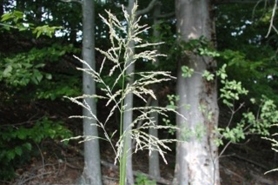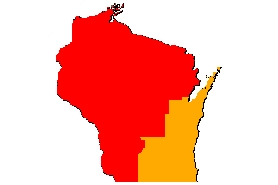Tall manna grass
(Glyceria maxima)
Semi-aquatic, perennial grass with unbranched stems up to 8’ tall—reddish tint on the lower parts of the stems.
Other names for this plant include:
- Common names: reed sweetgrass, reed manna grass, English water grass
- Scientific names: G. aquatica; G. spectabilis; Molinia maxima; Panicularia aquatica
Classification in Wisconsin: Prohibited/Restricted (Restricted in Brown, Calumet, Columbia, Dane, Dodge, Door, Fond du Lac, Green, Jefferson, Kenosha, Kewaunee, Manitowoc, Milwaukee, Outagamie, Ozaukee, Racine, Rock, Sheboygan, Walworth, Washington, Waukesha and Winnebago counties; Prohibited elsewhere)
- Ecological Threat
-
- Tall manna grass invades wetlands, including swamps, lakes, ponds, slow-moving rivers, creeks, ditches and wet pastures, forming monospecific stands capable of crowding native vegetation.
- It degrades wetland habitats because it is not suitable for nesting and is a poor food source for wildlife.
- Tall manna grass has been sold as an ornamental in a variegated variety.
- Young shoots can cause cyanide poisoning in cattle if used as forage.
- Identification
-
Leaves: Leaves protrude at an angle from the white base, with broad, flat, rough-edged blades, but firmly “V” shaped at their base. With a blade, leaf sheaths fused inches below juncture (in wetlands unique to Glyceria grasses).
Flowers: Erect, sturdy panicle with spikelets several-flowered (1-2.5 mm wide). Spikelet ovate, 5 to 10 mm long with lateral compression. Lemmas with conspicuously raised veins, awnless and upper glumes with one vein.
Fruits & seeds: Seeds are dark brown (1.5 to 2 mm long)
Stems: Unbranched up to 8 feet tall. It often lays down and appears shorter. 5-10 leaves per stem.
Roots: Rhizomes
Similar species: Glyceria grandis is shorter (5 feet); has smooth leaf edges; a weak, nodding panicle; 4 to 6 mm spikelets, and only 3-6 leaves per stem.
- Distribution
-
See the reported locations of tall manna grass in Wisconsin.
Do you know of additional populations? Please send us a report.
- Control
-
Mechanical: If feasible, black plastic can smother the infested area; cutting plants several times throughout the year can also effectively limit root reserves but may take a long time to kill the grass. Flooding can also be an effective method when the grass is cut.
Chemical: 3% solution of glyphosate in early and late summer. Follow up for several years.
- Resources
- Sources for content:
- Invasive Plant Atlas of New England: Reed mannagrass [exit DNR]
- Washington State Noxious Weed Control Board: Reed Sweetgrass [exit DNR] Fact Sheet.
- Martin, Tunyalee. The Nature Conservancy Global Invasive Species Team. Weed Alert! Reed sweetgrass [exit DNR]. Last updated January 2005.



